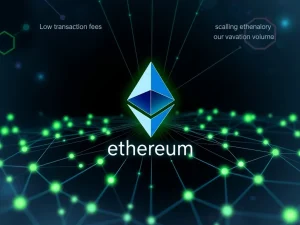Starknet’s Troubling Second Mainnet Outage Sparks Ethereum L2 Reliability Fears

The cryptocurrency world is once again buzzing with concerns after Starknet, a prominent Ethereum Layer-2 (L2) scaling solution, experienced its second significant mainnet outage in just two months. This recent incident, marked by a frozen network and disrupted transactions, has sparked crucial conversations about blockchain reliability and the robust infrastructure needed for decentralized networks to truly flourish. For many in the crypto community, these recurring issues raise questions about the readiness of scaling solutions for widespread adoption, particularly as the demand for efficient and dependable blockchain services continues to grow exponentially.
Starknet Suffers Another Critical Mainnet Outage
On a recent Tuesday, the Starknet mainnet suffered a substantial disruption, halting block production for nearly three hours. This unexpected downtime caused considerable delays, impacting countless users and forcing many to resubmit their transactions. The outage lasted precisely two hours and 44 minutes, leading to a noticeable slowdown in block creation and a complete stagnation of transactions across the network. Such events are particularly troubling for a platform positioned as a high-performance scaling solution for Ethereum, designed to handle vast amounts of activity. The incident immediately drew attention from investors and developers alike, scrutinizing the platform’s operational stability and its ability to deliver on its promise of scalable, low-cost transactions. This event serves as a stark reminder of the complexities involved in maintaining decentralized infrastructure.
Deep Dive into the Sequencer Failure and Cairo0 Code
The core of this latest disruption lay with Starknet’s sequencer, a critical component in its architecture. In blockchain operations, a sequencer acts as a vital traffic controller, diligently ordering transactions before their inclusion in a block. It plays a pivotal role in maintaining the flow and integrity of the network, ensuring that transactions are processed efficiently and in the correct sequence. During this mainnet outage, the Starknet sequencer encountered a critical problem: it failed to recognize “Cairo0 code.” Cairo0 is Starknet’s native smart contract language, specifically designed for its STARK-based architecture, which underpins its entire operation. This specific code recognition issue effectively paralyzed the network’s ability to process new data, preventing the smooth flow of operations. A sequencer’s inability to process its native code points to a fundamental bug or an unforeseen compatibility issue, prompting significant concerns about the system’s underlying robustness and resilience to such technical anomalies. The incident underscores the intricate dependencies within complex blockchain systems.
Ethereum L2 Reliability Under Scrutiny
This incident marks the second “major outage” on the Starknet mainnet within a short two-month period, creating significant apprehension among its user base and the broader crypto ecosystem. Such repeated disruptions naturally raise serious questions concerning the long-term blockchain reliability of Starknet. It currently ranks as Ethereum’s seventh-largest Ethereum L2 network, boasting a total value locked (TVL) of $548 million, according to data from L2beat.com. This substantial TVL signifies the trust and capital invested in the platform, making its stability even more critical. The previous outage on July 18 was shorter, affecting the network for only 13 minutes with slow block creation times and a sluggish gateway. However, the recent, longer downtime suggests a more profound issue that extends beyond minor performance hiccups. This situation highlights the critical need for unwavering stability in scaling solutions, especially as they handle substantial value and increasing user activity, pushing the boundaries of decentralized finance (DeFi) and Web3 applications.
Understanding ZK-Rollups and Starknet’s Advanced Technology
Ethereum L2 networks are secondary blockchains, meticulously built on top of the Ethereum mainnet. Their primary goal is to significantly enhance transaction speed and capacity, effectively addressing Ethereum’s inherent scalability limitations. They achieve this by processing transactions off-chain, thereby alleviating congestion and reducing gas fees on the mainnet. Starknet distinguishes itself by utilizing ZK-rollups, a sophisticated scaling technology that employs zero-knowledge proofs. Specifically, it uses STARK proofs (Scalable Transparent ARguments of Knowledge), which are known for their strong cryptographic guarantees and efficiency. These proofs enable high-throughput and low-cost transactions, effectively scaling the Ethereum mainnet to support a global user base. ZK-rollups bundle thousands of transactions into a single, cryptographically verifiable proof. This proof is then submitted to the Ethereum mainnet, which significantly reduces the data footprint and computational load while maintaining robust security guarantees inherent to Ethereum. This innovative approach promises a future of highly scalable and secure decentralized applications.
User Impact and the Imperative for Robust Systems
The direct consequences of such a mainnet outage extend far beyond mere technical fixes; they significantly impact the end-user experience and broader market confidence. For users, the requirement to resubmit transactions translates into lost time, potential financial losses due to missed trading opportunities, and considerable frustration. In a fast-moving market like cryptocurrency, even a few hours of downtime can be costly, affecting arbitrage strategies, liquidations, or time-sensitive trades. Furthermore, developers building decentralized applications (dApps) on Starknet might also face delays in deploying or updating their applications, impacting their project timelines, user base, and overall market competitiveness. The crypto industry operates on trust, and consistent blockchain reliability is paramount for fostering that trust. When a network experiences repeated failures, it inevitably erodes confidence, potentially driving users and projects towards more stable alternatives within the increasingly competitive L2 landscape. This underscores the critical need for L2s to prioritize uptime and resilience above all else.
Starknet’s Swift Recovery and Pending Transparency
Less than three hours after the outage began, Starknet announced its return to full functionality, a testament to its operational team’s rapid response capabilities. A community-member-run X account quickly confirmed the restoration. “Block production is back to normal,” the post stated, further adding, “Most RPC providers are up-and-running, and the remaining ones will upgrade shortly.” This rapid response demonstrates the team’s commitment to restoring service promptly. However, the recovery came with a significant caveat that directly affected users: transactions submitted between 2:23 am and 4:36 am UTC were not processed. A blockchain reorganization from block 1960612 was “committed,” representing one hour of activity. Consequently, all affected users had to resubmit their transactions, adding an extra layer of inconvenience and potential cost. The Starknet team has since promised a “full timeline,” which will include a detailed root cause analysis and long-term prevention measures, signaling a commitment to transparency and future improvements.
Broader Implications for Ethereum L2 Ecosystem and Decentralization
The repeated mainnet outage on Starknet has broader implications, affecting not just this specific network but the entire Ethereum L2 ecosystem and the vision of a decentralized future. Users and developers alike prioritize consistent performance and demand unwavering blockchain reliability from the infrastructure they depend on. Frequent disruptions can severely erode trust, potentially deterring new projects and users from adopting L2 solutions, regardless of their technological advancements like ZK-rollups. The competitive landscape for L2s is intense, with networks like Arbitrum, Optimism, and zkSync also vying for market share, each aiming to offer superior scalability, security, and stability. Therefore, maintaining impeccable uptime is paramount to ensure continued growth and adoption within the decentralized space. This incident serves as a critical stress test for the entire L2 paradigm, emphasizing the need for robust, fault-tolerant designs that can withstand unexpected technical challenges.
The Path Forward: Enhancing Starknet’s Resilience
To bolster its blockchain reliability and reassure its community, Starknet must implement comprehensive and proactive measures. This includes rigorous testing protocols, continuous infrastructure monitoring with advanced alert systems, and potentially exploring more decentralized sequencer models. A decentralized sequencer, for instance, could mitigate single points of failure, making the network inherently more resilient to individual component malfunctions or attacks. Furthermore, transparent communication about technical challenges and their resolutions is vital for rebuilding and maintaining community trust. As ZK-rollups technology matures, the focus will increasingly shift from merely achieving scalability to ensuring that scalability comes hand-in-hand with uncompromising stability, security, and a seamless user experience. The Starknet team’s upcoming detailed report will be crucial in demonstrating their commitment to addressing these fundamental challenges and reinforcing their position as a leading Ethereum L2 solution in a rapidly evolving ecosystem.
Conclusion:
Starknet’s recent mainnet outage serves as a stark reminder that the journey towards robust and scalable Ethereum L2 solutions is an ongoing process of innovation, refinement, and continuous improvement. While the network quickly restored service, the incident underscores critical challenges inherent in building complex decentralized systems designed for global scale. Ensuring consistent blockchain reliability remains a top priority for all L2s aiming for mass adoption, as user confidence is directly tied to network uptime. As ZK-rollups continue to evolve, the focus must extend beyond impressive speed and cost reductions; it must also encompass unwavering stability, ironclad security, and an uncompromised user experience. The crypto community eagerly awaits Starknet’s detailed post-mortem report, hoping it will shed more light on the incident and outline concrete measures to prevent future disruptions, ultimately strengthening the foundation upon which the future of Web3 is being built.









